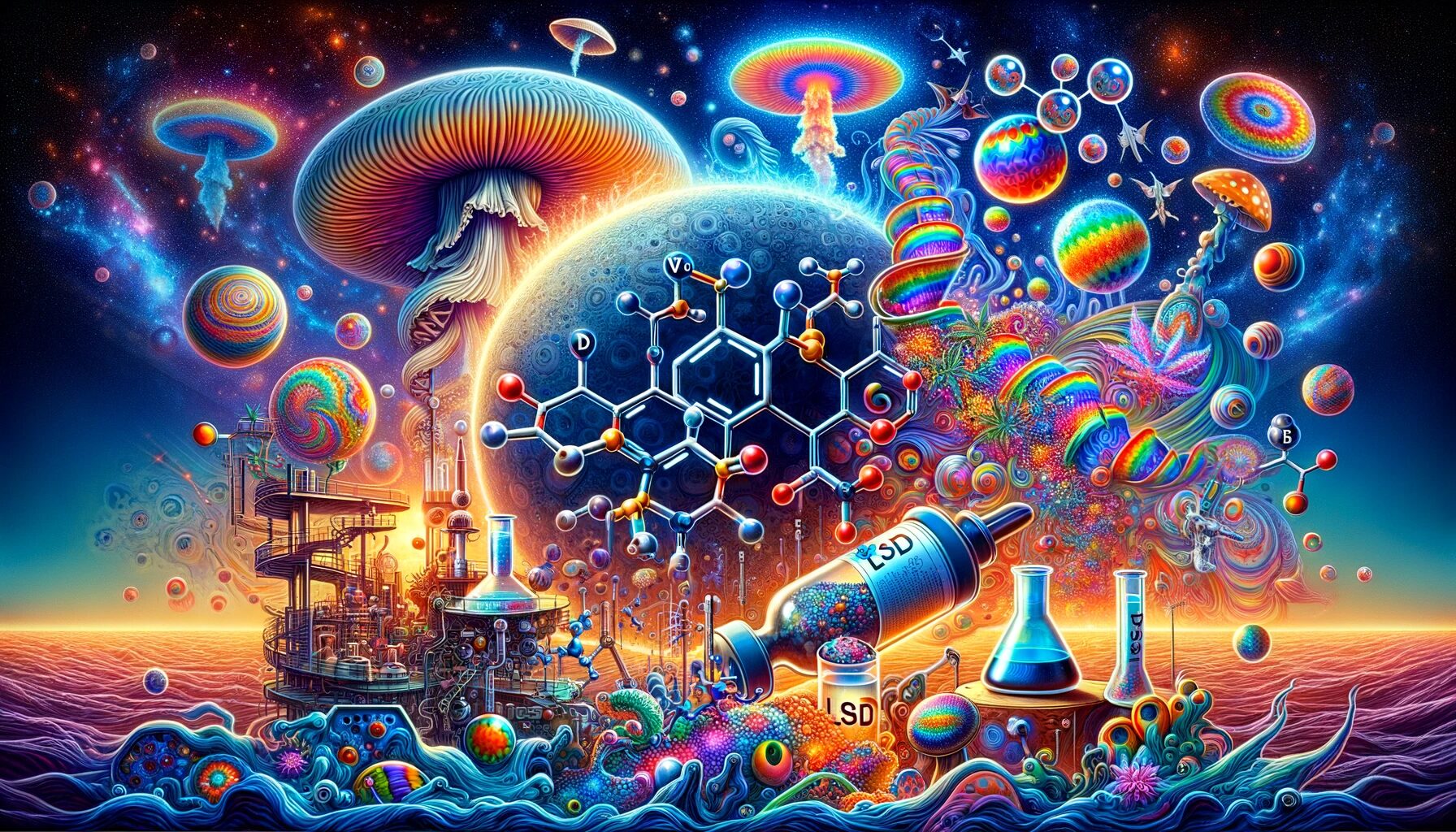Lysergic acid diethylamide (LSD), a substance once central to the psychedelic movement of the 1960s, remains one of the most potent and controversial hallucinogens. Synthesized in 1938 by Swiss chemist Albert Hofmann, LSD is renowned for its profound impact on consciousness, characterized by alterations in sensory perception, mood, and thought.
Despite its notoriety and classification as a Schedule I drug, LSD’s complex interplay of cultural, psychological, and pharmacological dimensions continues to captivate and challenge our understanding. This comprehensive exploration delves into the history, effects, and ongoing debates surrounding LSD, offering insights into its enduring enigma in both scientific and societal contexts.
1. Historical Context of LSD
- Discovery and Early Research: LSD was first synthesized in 1938 by Swiss chemist Albert Hofmann. Its hallucinogenic properties were discovered in 1943, leading to a wave of interest in its potential therapeutic uses, particularly in psychiatry.
- The 1960s and Cultural Shifts: In the 1960s, LSD became synonymous with countercultural movements, prompting widespread recreational use and subsequent legal crackdowns.
2. Pharmacology of LSD
- Chemical Structure: LSD is a semi-synthetic compound derived from ergot, a fungus that grows on rye and other grains.
- Mechanism of Action: It primarily affects the brain’s serotonin receptors, particularly 5-HT2A, altering mood, cognition, and perception.
3. LSD’s Effects on the Brain and Body
- Immediate Physical Effects: These can include dilated pupils, increased heart rate, higher body temperature, and tremors.
- Neurological Impact: LSD causes an altered state of consciousness, with effects ranging from visual hallucinations to profound shifts in thought and mood.
4. The LSD Experience: Duration and Phases
- Onset: The effects start 20 minutes to an hour after ingestion.
- Peak Phase: The most intense part of the experience, 2 to 5 hours post-ingestion.
- Plateau: A period of stabilized effects lasting 2 to 4 hours.
- Come Down: Gradual decrease in intensity.
- After Effects: Residual feelings or thoughts, lasting hours or days.
5. Individual Variability in LSD Experiences
- Personal Factors: Age, body weight, mental state, and expectations can significantly influence the LSD experience.
- Setting: The environment in which LSD is taken plays a crucial role in shaping the experience.
6. Risks and Safety Concerns
- Physical Risks: While LSD is not toxic in typical doses, it can lead to dangerous behaviors due to altered perception.
- Psychological Risks: These include the potential for “bad trips,” flashbacks, and triggering or worsening of mental health conditions.
- Dependence and Tolerance: LSD is not addictive in the conventional sense, but users can develop tolerance.
7. LSD in Therapy and Research
- Psychotherapeutic Use: Early research into LSD suggested potential benefits for treating various psychological disorders.
- Contemporary Studies: Recent studies have revisited LSD’s potential in treating conditions like depression, PTSD, and anxiety, especially in terminal illnesses.
8. Legal Status and Social Perceptions
- Controlled Substance: LSD is classified as a Schedule I drug in the United States, indicating a high potential for abuse and no accepted medical use.
- Shifting Attitudes: The ongoing research into psychedelics is gradually changing public and scientific perceptions of LSD.
9. Government and Legal Information
- DEA’s LSD Fact Sheet: The DEA’s LSD Drug Fact Sheet provides detailed information about the drug’s effects, legal status, and more.
- Justice Department’s Archive: The LSD Fast Facts from the U.S. Department of Justice offer historical and legal perspectives on LSD.
Conclusion
The duration and experience of an LSD trip are influenced by numerous factors, including dosage, individual biochemistry, and environmental context. The effects typically last 8 to 12 hours, with potential residual impacts. LSD’s role in culture, law, and medicine continues to evolve, reflecting changes in societal attitudes and scientific understanding.
FAQs
Q1: What is LSD?
- A1: LSD, short for lysergic acid diethylamide, is a powerful psychoactive substance known for its strong effects on consciousness. It’s a hallucinogenic drug that alters perceptions, emotions, and thoughts.
Q2: How long does an LSD trip last?
- A2: The effects of an LSD trip can vary, but typically they last between 8 to 12 hours. Factors like dosage, individual biochemistry, and the environment can affect the duration and intensity of the experience.
Q3: Is LSD addictive?
- A3: LSD is not considered addictive in the traditional sense as it does not produce compulsive drug-seeking behavior. However, users can develop tolerance to its effects.
Q4: Can LSD have therapeutic uses?
- A4: While LSD is currently classified as a Schedule I drug with no accepted medical use in treatment in the United States, recent research has explored its potential therapeutic benefits, particularly in treating conditions like depression and PTSD.
Q5: What are the risks of taking LSD?
- A5: Risks include the potential for experiencing ‘bad trips,’ which can be psychologically distressing, flashbacks, and the exacerbation of mental health issues. It’s important to note that while LSD is not toxic, it can lead to dangerous behaviors due to its profound effects on perception and judgment.
Q6: Is LSD legal?
- A6: LSD is illegal in most countries, including the United States, where it is classified as a Schedule I substance under the Controlled Substances Act. This classification is for drugs with a high potential for abuse and no accepted medical use.

Alex is a seasoned writer and researcher, specializing in psychedelic studies and mental health. Known for insightful and authoritative content, he combines extensive knowledge with a passion for exploring wellness and alternative therapies. Alex’s work is a trusted resource for readers delving into the world of mental well-being.


Leave a Reply